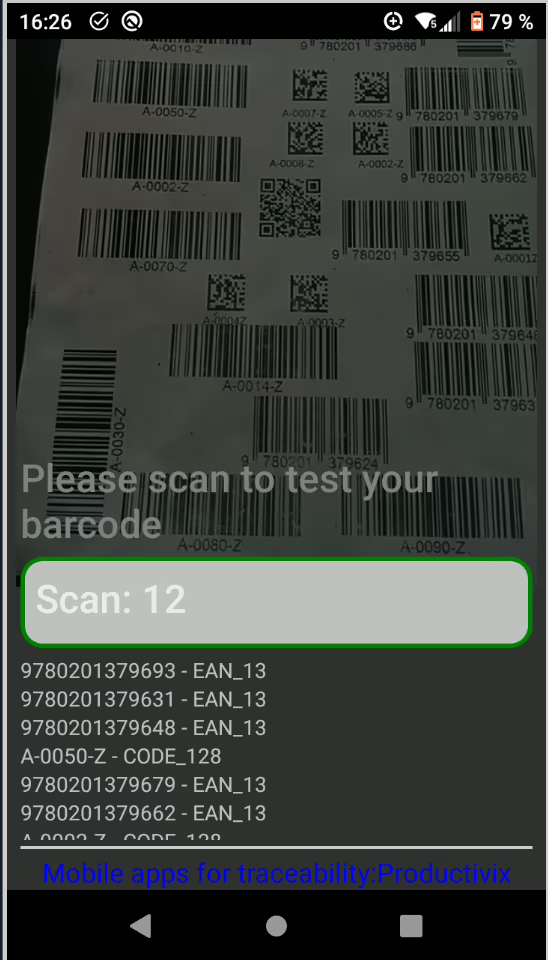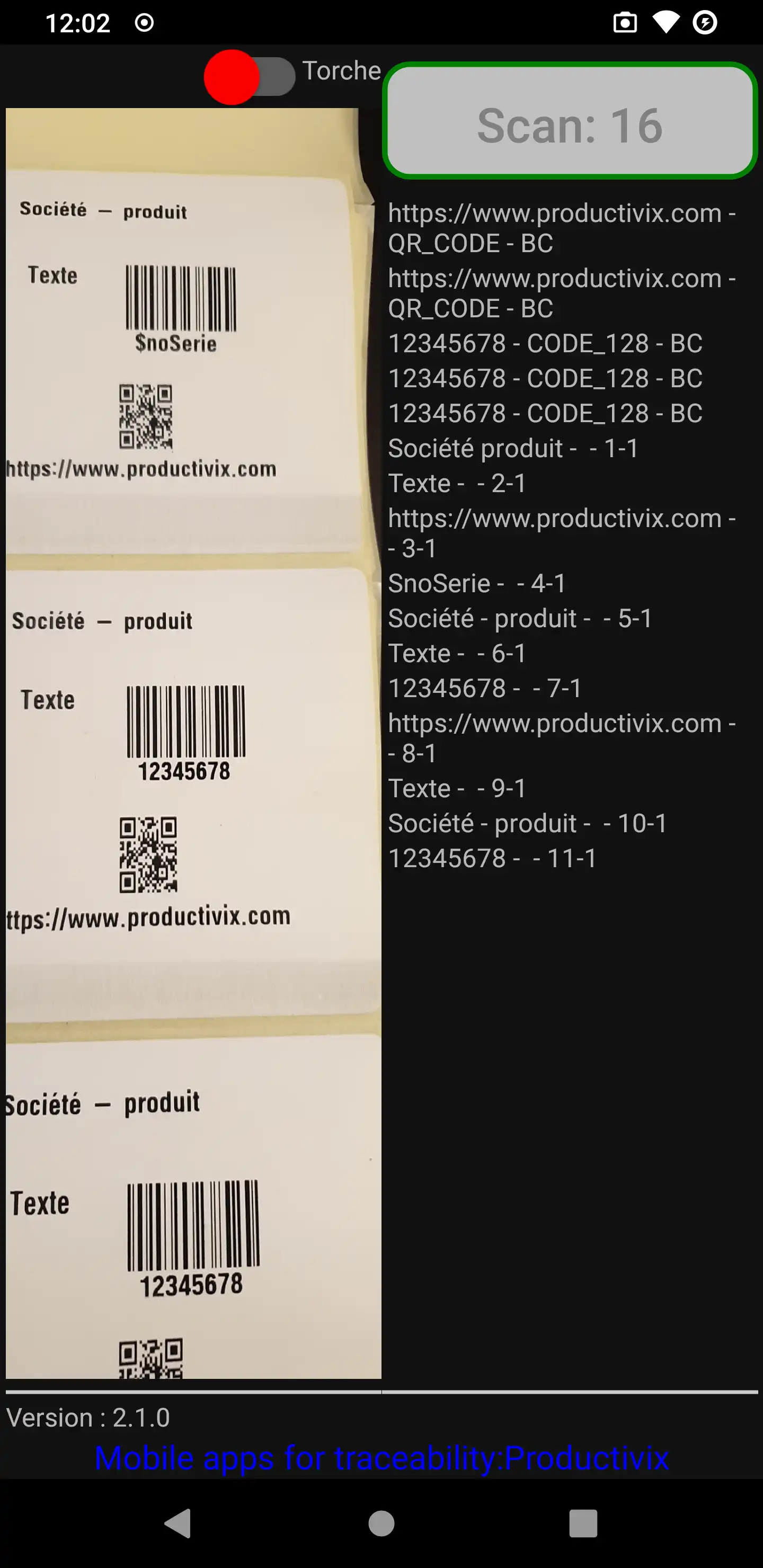we develop our own camera scan drivers for Android: you’ll always get the best performance from your Android!
In Oct 2022, we developed our own new driver for scanning faster than ever before by Android smartphone camera, and we’ve just improved it.
How fast will you need to scan barcodes with your Android device? The camera or a barcode terminal with integrated imager/scanner?
Impact on the cost of ownership of the mobile scanning solution. Comparisons.
Which mobile can I scan with?
Basically, you can scan with a smartphone camera, whether Android or Apple (ios). Then on more complex devices, with an integrated 1D scanner or 2D imager (integrated scanner), but this depends on the embedded driver in these devices, whether it can be accessed by software or not (“SDK” supplied, which require integration work).
Barcode scanning speed depends on :
- the quality of the optics, the firmware of your camera (always the one on the back of the device), imager or scanner integrated into your smartphone, in this case called a “rugged terminal”.
- the quality, font and size of your printed barcodes: if you have items or labels that you don’t know how to print, reading the barcode font (see barcode reading principle) will take more or less seconds or milliseconds, depending on the reader, or may not be readable at all!
- the position of the barcodes on the label: proximity, number, white “quiet zone” around each one,
- software ergonomics: the position of keys and touchpads will save you one or two seconds per scan,
- the amount of information to be completed by the operator: this depends on the needs of the application.
Here, we’ll concentrate on the first 3 points.
Which application for which machine?
We develop Android applications that generally integrate both reading technologies:
- on terminals with integrated scanners, which integrate the latest programs known to manufacturers and their reading heads.
- on smartphones via the camera.
Camera: an acceptable alternative to the imager with our camera scan driver
As developers, we’ve been concentrating on improving the cheapest solution for our customers: the smartphone camera. We developed a new driver, almost twice as fast as the old ones, which we have been integrating into our new traceability applications since the end of October 2022. It was upgraded in October 2023.
Impact of scan speed on installation costs
We have measured that, for the same simple application, you can save three (3) times more time with an integrated scanner than with a smartphone with the classic camera driver.
Unfortunately, this comes at a price:
- in hardware: terminals with scanners are much more expensive, some in the same proportion,
- in development: integrating the access libraries for these scanners takes time, specifically for each piece of hardware required, and is therefore passed on to the costs of participating in the development and updating the programs, and therefore the license.
- So, the right question to ask before requesting development or mobile scan configuration
- At what minimum speed will I need to scan? At what distance will I need to scan?
With these two questions in mind, we decided to look at the classic camera driver.
After a month’s development, we’ve come up with a solution for mid-range cameras (if this development is any good, it’ll be even better with better cameras), which allows you to spend just 50% more time than with an imager. The better the camera, the better the ratio.

Camera reads a dozen barcodes in 5 seconds in low light
To give levels of speed values, in close reading, you can scan, with the you can scan, with validation key (for work) at speeds FOR 10 different barcodes, in different positions, up to approx:
- 70 seconds with your smartphone’s camera (depending on optics and on-board firmware, here classic)
- 25 seconds with integrated scanner, (scanning one by one)
- and with our camera driver, it takes 38 seconds, or even 10 seconds in special continuous scan mode.
So : is the choice of terminal with imager necessary for close reading? ?
The imager has undeniable advantages in medium and long-range reading, white codes on transparent or black backgrounds, and on extremely small codes (4 to 8 mm) is another factor to take into account.
With regard to the reading distance, the size of the printed barcode must also be taken into account see barcode reading principle
About reading most standard formats / fonts / symbologies:
- linear formats: Codabar, Code 39, Code 93, Code 128, EAN-8, EAN-13, ITF, UPC-A et UPC-E
- 2D formats: Aztec, Data Matrix, PDF417, code QR
For goods-in, inventory and shipping scanning processes, our software, backed by our suppliers’ technologies, captures and verifies hundreds of barcodes simultaneously, with a 100% detection rate.
If you already have an Android terminal and would like to test your printed labels with our drivers, with a view to entrusting us with a development project, please contact us.
We can add OCR reading (scanning, optical character recognition) to barcode reading: our demo app lets you test everything on your own media and labels.

Screenshot of our barcode reading and OCR camera test app
New free demo app for 1-shot camera scanning:
- 10 to 12 different codes at a time, Zoom, barcode + OCR, characters
- Range 1 meter and more (depending on camera)
- Wide view, in low light
- offline, 1 press = 1 treatment
Apk provided on Productivix private repository, on request - link and loading QRcode provided To install, read here
—Version 2.1.0: 18/01/24
Depends on the most recent automatic vision libraries available.
Works only on Android beyond package 21 (Android 5 - Lollipop). Please allow both requests on 1st startup for proper operation.
Results depend on :
- the quality, cleanliness and definition of the camera on the back of the device
- the inclination of the device relative to the stand when the ‘scan’ button is pressed
- character quality, flatness and cleanliness of the media to be scanned.
No limits, no data stored in the phone or communicated on the net.
Allows you to test the repeatability of readings, the qualification of barcodes or label models, the position of bars or frames around barcodes (classic case).
This module can be integrated into an app page.
The bar code symbologies detectable in vision on this latest version are listed on this same page.
For other symbologies, please refer to the ‘PRX’ list of professional terminals with imagers in this link. The flashlight can be activated by button (it switches off manually or automatically when the app disappears from the screen), the flash is automatic and the light intensifier in low-light situations, if your camera allows it, will be activated.
For reading very small barcodes, Datamatrix, or characters or reading from a distance: the camera part allows you to ZOOM in with 2 diagonal fingers (this can be set up in a custom app if constant).
Shooting goes far beyond what is visible in the reduced window, depending on the position of this module in the app.
A single button to trigger reading: “scan”, which displays the number of pieces of information read: barcode type (BC) + OCR lines. A positive beep is emitted if at least one decoding, a negative beep if nothing.
Display of decoded data: explanations :
https://www.productivix.com - QR_CODE - BC
12345678 - CODE_128 - BC
12345678 - CODE_128 - BC
Windows 1-1
Sociêté 2-1
Texte 3-1
prot uit 4-1
https:|[wwN.productivix.com 5-1
Texte 6-1
SnoSerie 7-1
Société - produit 8-1
Texte 9-1
12345678 10-1
https://www.productivix.com 11-1
Société - produit 12-1
12345678 13-1
“12345678 - CODE_128 - BC” gives, as many times as found, the value of the barcode, its font (symbology), BC stands for ‘barcode’.
“Sociêté 2-1” is the line 1 recognized from characters (you’ll appreciate the possible errors in OCR) of block 2 (the blocks are defined by the library).
In a custom app, these elements can be used to do anything, from reading them to ignoring them, as long as they are repetitive and positioned relative to each other.
